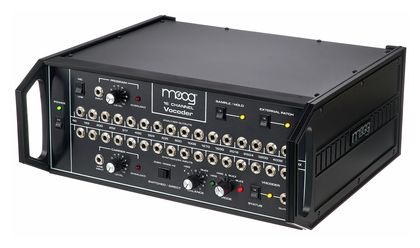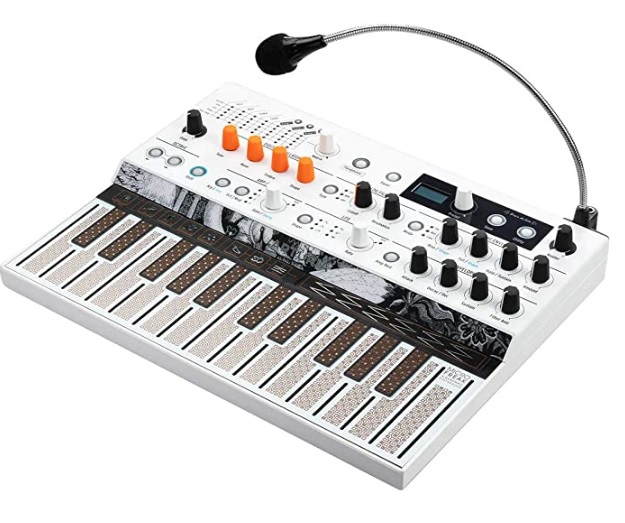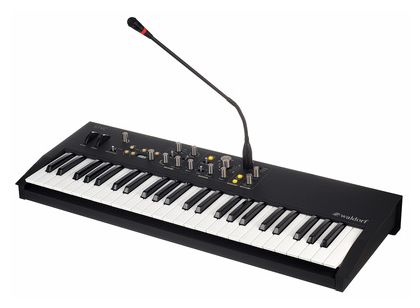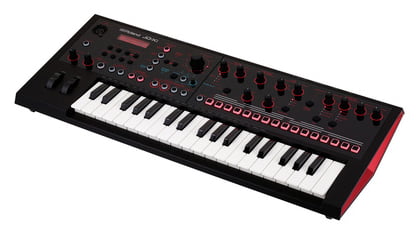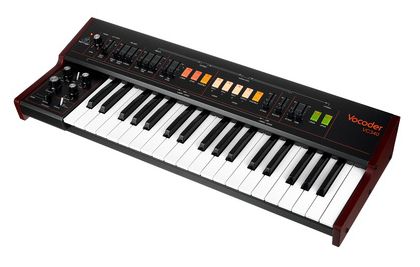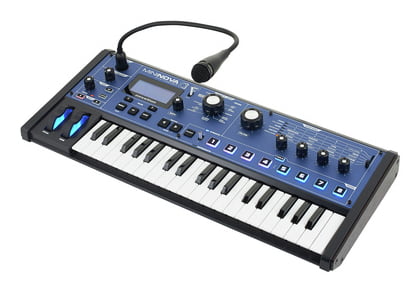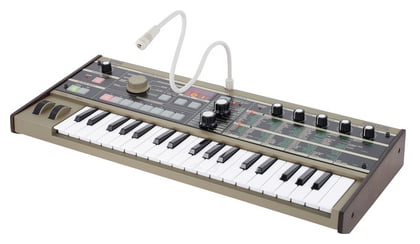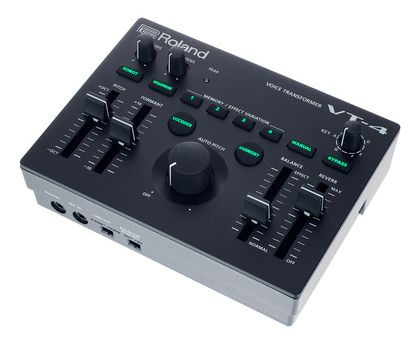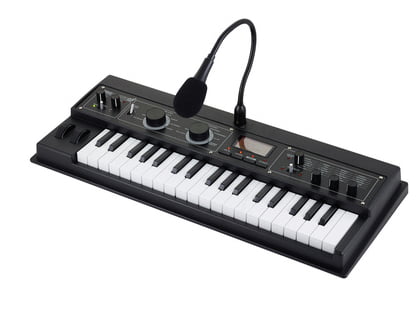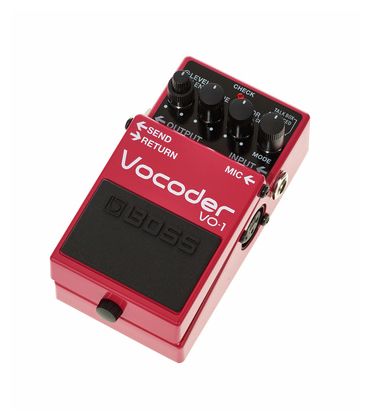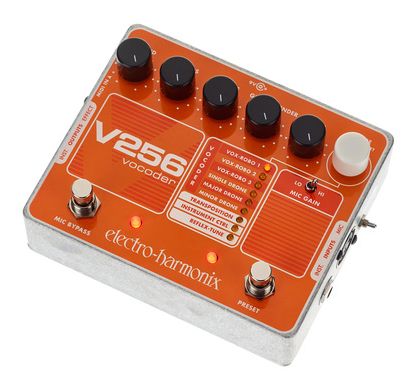In this article, we shall see the best hardware vocoders available in the market.
The Vocoder was initially created by Homer Dudley at Bell Labs in 1938 to synthesize the human voice to send encrypted messages. Later, musicians found it and started to create art out of it, and it became a well-known sound in electronic music and is also the signature sound of artists like Daft Punk, Zedd, Beastie Boys, and more.
A vocoder works because there are two types of signals: modulator and carrier. You pass the modulator signal, usually a human voice, through a bank of filters, such that the levels of the filters are set as per the human modulator signal. Those filter levels are then impressed upon the carrier signal coming from another instrument, usually a synth.
That makes the harmonic content of the carrier waveform similar to that of the modulator signal, and you get an interesting output of the synth imitating the human voice. Now, let’s look at the list of the best hardware vocoders we have compiled for you in the market.
Top 11 Hardware Vocoders 2024 (Best Synths & Pedals)
1. Moog Vocoder
Moog Vocoder is a 16-band and 16-channel vocoder originally released in 1979.
It is an analog processor with two inputs: program and carrier signals. The program signal is usually vocal, and the carrier signal is usually an instrument or synth. Further, it splits the input into 16 different frequency bands, ranging from 50 Hz to 5,600 Hz, each of which could be tweaked and edited as per your sensibilities.
Many industry professionals, producers, and artists recognize the sonic characteristics of Vocoder by Moog. Giorgio Moroder iconized its sound, Daft Punk commercialized it, and Fitzgerald called it “the best-sounding vocoder”.
Key Features:
- Distinct Sound
Its unique sound is embarked by features like Sample/Hold, which lets you capture the tonality of the program input for extended or sustained phrases.
In addition, you can add more sibilance to the output using the hiss knob, weight by using the buzz knob, or make the sound stick to its fundamental frequency, using the balance knob.
- Flexibility
You can feed a particular frequency band of the program into another frequency band of the carrier signal and perform cross patches and cross-band processing. For each frequency band, there are two separate strips for input and output patching, which gives freedom for full external patching between synth and vocoder sections.
- Tough build
It has a rugged build with high-quality patches and inserts, buttons of good resolution, and an overall analog circuitry that adds the required analog warmth to the sound. The well-built machinery makes the experience great.
- DIRECT Mode
Apart from the sixteen bands between 50 and 5080 Hz, it also allows for a high-frequency band above 5.08 kHz to preserve the vocals’ timbral, dynamic, and transient characteristics, so it sounds like a vocal and not just a synth.
Character & Sound:
The Moog Vocoder is great at creating lush, ambient, and sparse vocal synths with solid width and depth. In addition, you can create choral parts to the sounds, create unique harmonies by experimenting with different intervals on the instrument you’re playing, and play around a lot more.
Overall, you can impress the envelope, timbre, articulation, and other expressions to your output by your vocals. It has a nice analog warmth, but the sound also depends on the instrument, mic, and vocals you’re inputting into the device.
Pros:
You can connect any instrument to ut, like a guitar or any synth, and adapt its articulation and expression to whatever input you use as a program. Secondly, additional features like sample/hold, cross-band feeding, and cross-channel feeding are huge pros.
Cons:
It doesn’t have an in-built piano, oscillators, or any sound sources, and you need an external synth or instrument to work with it, which could be expensive for some artists/producers. In addition, it has only one line input; hence, to connect computer audio as input, you need to have a line output from the interface.
2. Arturia MicroFreak Vocoder Edition
Arturia Microfreak is a digital synthesizer with a sixteen-band vocoder module.
Its synth engine is exactly that of the Arturia Microfreak, including its digital oscillator, wavetable oscillator, analog filters, modulation matrix, and more, giving you the flexibility to create and design your carrier signal with great flexibility. It also has a 64-step sequencer, arpeggiator, chord mode, and more features.
Key Features:
- Sound Engine & flexibility
You can start with three waveforms: sawtooth, pulse width, and noise and voicing up to four voices, along with a wavetable oscillator and timbre and shape knobs for further sonic shaping. The modulation matrix allows pitch, waveform, timer, cut-off, and three assignable parameters to be modulated by an envelope, LFO, key/arp, and cycle envelope.
- Ease of use
The interface and signal flow are simple and easy to understand, and there are 224 factory presets and sixteen Vocoder presets to get started with. The chord mode allows you to play diatonic chords by pressing a single key as the root note. In addition, there’s also a small OLED screen for visual feedback and, reading & setting the values.
- Vocoder engine
The synth sound is adapted to the voice envelope and timbre and is then outputted. So you can control the sonic characteristics of the output by knobs like Type, Wave, Timbre, and Shape.
Further, you can filter those sounds, module them using LFO and ADSR envelope, create arpeggiation and sequencer patterns, and more. Finally, you can easily get started with the Vocoder using the Vocoder presets built into the synth.
- Effects
There are options for pitch modulation and a glide knob to add creative pitch effects. Further, you can add high-quality effects like compressor, reverb, delay, and more for further sonic shaping.
Character & Sound:
It has smooth and classic analog filters of lowpass, bandpass, and highpass types, adding analog warmth to the sound. Multi-mode arpeggiator with Up, Order, Random, Pattern modes, and a 64-step sequencer account for great movement and rhythmic possibilities.
Wavetable synthesis allows for an expansive scope of sonic range that you can tap into. Lastly, it’s great for glitchy underground vocal synth sounds and creating interesting & experimental vocal effects in your songs.
Pros:
You can add any TRRS input or adapter as a microphone to the synth, and the updates are free. It’s a good trimmed-down version of Vocoder, with a versatile sound design engine. Lastly, it’s portable, has a great interface, and can be incredibly inspiring, especially during touring.
Cons:
It doesn’t have a proper mic input, like an XLR or line input, for high-recording high-quality vocals. Further, it doesn’t have the expansive features of a modern vocoder and is more like a compromised version. As a synthesizer with a vocoder, it’s good, but just as a vocoder, it is not the right product.
3. Waldorf STVC
STVC by Waldorf is a string synthesizer integrated with a vocoder.
It is based on the famous Streichfett String Synthesizer with 49-keys aftertouch enabled keyboard, coupled with pitch bend and mod wheels, and an OLED screen, packaged in a well-built metal box with 126 programmable patches in three banks. In addition, the Vocoder comes with a polyphonic carrier and a gender modification option.
Key Features:
- Unique sound
The synth string sound is the signature sound of many incredible 70s and 80s songs, is also used in much modern retro pop, and has a nostalgic & feel-good vibe. It sounds huge, lush, and smooth, and when combined with a vocoder, it sounds even more unique.
- Sonic shaping
You get a tremolo effect that adds energy to your sounds and makes them more stereo. In addition, the envelope controls let you control the ADSR of the sounds, allowing you to shape the transient nature of the sound, shaping the percussive and melodic sounds differently.
Further, the solo section lets you split the keys by which high or low cutoff is set to the solo tone.
- Effects and modulations
You can add effects like Animate, Phaser, and Reverb and control their mixes, such that the Animate option modulates the strings using LFO. All three effects are of great quality and resolution.
Character & Sound:
You get string sounds from Violin, Viola, Cello, Brass, Organ, Choir, and more for creating rich and creamy sounds with unique vintage-flavored strings. In addition, you can morph between five classic synth sounds, by which you can create anything from bass, lead, pluck, etc.
The Vocoder lets you edit speed, intelligibility, polyphony, and gender modification. You can also separate or split sounds using the solos section.
Pros:
There are twelve memory slots you get to save your sounds. On top of that, there are MIDI, XLR mic input, 2 x 1/4 inch outputs, and USB connectivity open to expanding the device and using it in combination with other instruments. On top of that, it’s built like a tank and blends & layers different sounds well.
Cons:
The solo section doesn’t have a filter, and the synth overall lacks an arpeggiator. Another huge con is that the reverb effect acts globally and applies parallel to the entire output.
4. Roland JD-Xi
JD-Xi is an analog/digital crossover synthesizer with a vocoder.
It has a 4-track pattern sequencer, auto-pitch, USB for audio/MIDI connectivity, and more. In addition, you get 128 voices of polyphony, 19 effects, professional drum kits, and plenty of ready-to-play patterns and sounds. Overall, it’s a small and lightweight instrument with a versatile sonic palette, punchy drum kit, and a real analog flavor.
Key Features:
- SuperNATURAL synth engine
There’s no doubt that the synth has a versatile and deep-sounding analog synth engine with digital controls, which give you the best of both worlds: great sound and on-hand control.
- Sound Engine
To get started, there are 256 digital presets, 64 analog presets, and 32 drum kits. Then, you get an oscillator and a sub-oscillator, and options like brass, strings/pad, lead, etc., as the main sound source, beyond which you can apply a filter, envelope, LFO, and multiple effects like distortion, delay, reverb, compressor, bitcrusher, etc.
- Easy workflow
The signal path is straightforward and streamlined, and you can easily navigate it. In addition, the workflow is simple; for example, tapping the tempo is incredibly easy, and you have an easy XLR mic and USB/MIDI connectivity.
Character & Sound:
The bass sounds are warm and fat, and the lead sounds are upfront, with incredible pads, strings, brass, and more. It has a decent-quality gooseneck mic with an auto-pitch attached to it. The synth tones are great & natural, with up to 128 voices of polyphony. Vocoder Presets like VP330 and Robot is great! You can also download and load additional sounds into the synth.
Pros:
The USB for DAW connection is a huge pro, making the synth act like a 16-bit/44kHz 2in/2out USB Audio/MIDI interface. It has a good build, sturdy knob, great onboard parameters, and translucent rubber backlit selector buttons. Auto-pitch is another great tool to correct wrongly sung notes.
Cons:
The mic doesn’t have a gain control and no battery power option. The digital parts can’t easily be routed through the analog filters. Further, the keys are small and may cause resistance while playing.
5. Behringer Vocoder VC340
The VC340 is an analog string machine and Vocoder.
It has 37 semi-weighted full-size keys with velocity sensitivity, original analog circuitry, and signals path, ensuring inspiring synth sounds and vocoders. It has flexible sound shaping options and a distinct vintage flavor, especially in its string sounds. It is known for its hybrid stringy synth and choir-based sounds.
Key Features:
- Aesthetically pleasing
The design seems to be inspired by the MK2, as it has organic color on some switches and faders. It has a vintage aesthetic, a wooden cover, and a solid overall build. It’s small with only three octaves of keys, making it portable and looking good.
- Completely Analogue
The VC340 by Behringer is very reminiscent of the string machine era due to its design. Its purely analog circuitry ensures full polyphony and preservation of the warm vintage sound.
- Synthe Engine
You can select a gender in the human voice section and add ensemble effects that widen your sounds and open up their stereo imaging. Further, you can also add and control movements using LFO. Overall, it offers a nice thick texture, which sounds big and classy.
Character & Sound:
It’s great for modern vocal-synth effects and for emulating sounds of Daft Punk, Georgio Moroder, Zedd, etc. The high-quality sonic characteristics also support modern electronic music genres like house, techno, dubstep, future bass, bass house, etc. It sounds royally retro and analog and is great for creating rich choral effects and silky smooth strings.
Pros:
The biggest pro of the VC340 is its simplified workflow yet great sonic possibilities. Another great thing about it is its honest & faithful design & synth architecture, as it stays true to its roots and gives you exactly what you expect from it, nothing more and nothing less. Lastly, it’s heavy and quite durable.
Cons:
Thirty-seven keys may not be enough, especially for keyboard players who are also performing musicians. Secondly, the synth is good for strings and vocals but is not a versatile synthesizer and comes under niche uses. Finally, the human voices don’t sound realistic without the ensemble effect, and their usability is limited.
6. Novation MiniNova
Mininova is a three-octave mini synthesizer with a powerful sound engine of the UltraNova.
It has 37 velocity-sensitive keys, a pitch and modulation wheel, a filter knob, four performance knobs, and a switch for adding effects.
Key Features:
- Animate effects
You have eight pads that you can use to arpeggiate and animate your sounds. Using this, you can add cool articulations and effects to your sounds, using custom animations and activating multiple animations simultaneously. You can also save the patches you like by using the Favorite button.
- Arpeggiator
There’s a tempo knob you get under the Arp section in which you can sync the arpeggiator’s timings to the tempo. A latch button lets you keep hearing the sound without having to hold on to the keys. Finally, you get a switch by which you can flip the pads from being animated to being arpeggiated.
- Sound Engine
You get 14 types of highly-responsive and smooth filters, including high pass, low pass, and band pass, with different variations of slopes and resonances. There are six envelopes, out of which four can be applied to any parameter. These envelopes are snappy and responsive, so you can sculpt your sound however you want.
- Attractive Price Point
At a $399 price point, the features you get on the portable and highly-functional MiniNova are insane at the time of writing this article. It has the sound engine of the UltraNova so you can load its patches into the instrument.
Character & Sound:
There are 256 pre-loaded presets in the synth that you could go through and 128 available slots to save your patches. You can browse through the sounds using a data knob and select categories of type (bass, keyboard, pads, etc.) and genre (dubstep, house, rock, pop., etc.).
You can also load external sound packs from online sources or the Novation website. Overall, it has a versatile range of sounds, given its analog-style oscillators with a wide frequency range and immense punch, combined with oscillators, envelopes, and other modulators and effects for sonic shaping.
Pros:
It’s well-built and one of the most affordable yet feature-heavy sound design tools. Its portability makes it great for touring and instant music production during inspiration. In addition, it has a great aesthetic, simple workflow, and dials & knobs that let you scroll through the options quite easily.
Cons:
The biggest con of the synth is that it’s mono-timbral. Apart from that, the Vocoder is a bit disappointing in terms of clarity, and the reverb and other effects could have been better. There’s no battery power, and the keys are also very small for live-performing keyboard/synth players.
Choose If:
You want a portable sound design machine that is reasonably priced and that is optimized for electronic music production. In addition, the Vocoder and mic increase its usability and scope and make it more versatile.
7. Korg MicroKorg
MicroKorg is an analog-style portable synthesizer with an 8-band vocoder and microphone.
It features dual-oscillator digital signal processing, analog modeling, and a huge range of waveforms on the oscillator. You can run external instruments using its audio input jacks. It has 37 velocity-sensitive keys and four voices of polyphony. Plus, there are four filter modes and three types of modulation effects (chorus/flanger, phaser, and ensemble).
Key Features:
- Powerful Synthesis
It functions on 6 AA batteries, and you can play the synthesizer in both polyphonic and true monophonic modes. There are effects like portamento, vibrato, waveforms like saw, square, triangle, sine, vox, DWGS (more in a moment), and noise types.
You also have the option to have pulse width and cross-modulation between the oscillators present in the synth.
- Advanced Filters
The filters have 12 dB/octave and 24 dB/octave slopes with low-, high- and bandpass variants, with basic cutoff and resonance controls. You can also add an ADSR envelope and key-tracking modulations to the filters.
- 8-band Vocoder
The Vocoder in the synthesizer has some interesting features, such as you can freeze the sound formats and then play it across the keyboard without speaking into the mic repeatedly.
You can also shift the formats to change the gender and age of the voice. On top of that, you can add modulations, filters, and effects to your sounds.
Also, you can get creative with the Vocoder by using different voices and instruments as the carrier and modulator signals, as there are no restrictions.
- Other features
On your sounds, you can have onboard effects like flanger, chorus, ensemble, delay of various kinds, two-band eq, etc. onboard effects like flanger, chorus, ensemble, delay of various kinds, and two-band eq.
Plus, there’s also an arpeggiator on which you can have six variations of movements of notes and a trigger option for staccato of the arpeggiated notes. Further, the global settings allow great flexibility for editing & shaping the sounds.
Character & Sound:
MicroKorg has 128 presets to get started with, which include sounds of varying electronic genres, ranges, and musical styles. In addition, the modulation effects like delays, phaser, EQ, etc., line/mic input, and 6-types arpeggiator give you great flexibility over your sounds.
The 128 programs are categorized into techno, trance, electronica, DnB, Hip-hop/Vintage, etc.
It has a great analog-based circuitry that produces warm, fat, and punchy sounds and has the same sound engine as the MS2000. It’s great for anything from creating funky leads to atmospheric pads to vintage strings fat & thumpy bass sounds, and more.
Pros:
It’s an extremely versatile tool for sound design purposes and creating different genres of EDM, pop & hip-hop, and its low-end sounds great because of its analog framework. The workflow and signal path is simplified and easy and its also easy to carry due to their compact and light physical nature.
Cons:
It has a steep learning curve, and it may take some time to develop muscle memory and an overall workflow around it; hence editing it can be a task. Lastly, since it is battery-powered, you don’t get that complete analog flow and texture in the sound, although there’s a touch.
8. Roland VT-4
VT-4 by Roland is a voice transformer and vocal processing hardware device.
You can correct pitch, create vocoder effects, harmonies, pitch shifts, and more using the Roland VT-4. It’s a great tool for solo artists/singers/producers, DJs, and vocalists. It’s straightforward, streamlined, and easy to use, with minimal menu diving and no complications.
Key Features:
- Great Effects
You can add robotic effects with +/- 1 octave of range and feedback functions. Further, the Megaphone mode includes megaphone, radio, BBD chorus, and Strobo effects.
Vocoder effects include talkbox, VP, and spell toy, and you can create harmonies of different semi-tone settings & variations. In addition, you can also add reverb, tempo delay, echo, and dub echo by using the Reverb module.
- Ease of use
The VT-4 is small in size and has 5 hours of battery use. Hence, it’s great for touring and highly portable. There’s no programming involved, and it sounds great with 24-bit/192 kHz audio quality. In addition, you can connect an XLR-1/4 inch and 1/8 inch mic to it to record and perform high-quality vocals.
Character & Sound:
You can use the formant and pitch sliders to add more dimensions, gender, and age to the voice, and the varying vocal effects give you a good range of sonic palettes. In addition, you can trigger a four-note chord using the harmony button and a MIDI/DAW and create organic harmonic effects in real time.
Pros:
The Excellent pitch tracking and correction of the same pitch are incredible, with a MIDI pitch control with up to four harmonies making it an ideal device for a serious user. The battery lasts up to 6 hours, making it an excellent machine. Also, it can double up as an audio interface too.
Cons:
It has no class-compliant USB driver available for expanding its connectivity. On the internet, there’s a lot of criticism around its pitch correction and harmony creation abilities, so ensure that you test the device before buying.
9. KORG microKORG XL+
Microkorg XL+ is 37 keys, eight-voice synthesizer with a sixteen-band vocoder.
It resembles a typical digital piano with an LCD screen, USB connection, and varying effects algorithms. It features the classic Radius sound engine, giving it its analog warmth and texture. It also makes it versatile, as it can create fat bass sounds to punchy leads to thick pads.
Key Features:
- Sound selection knobs
The knobs let you browse the sounds by genre and instrument categories, so you can easily find the sound you’re looking for. In addition, you can layer sounds, split them, and layer them with an external source to expand your sonic horizon.
- Flexibility of use
Its battery-charged option enables you to play it in a car, park, or studio, anywhere you like. It can also be used as a USB/MIDI controller and can work with phones. It doesn’t necessarily require a laptop/computer. On top of that, it’s compact and easy to use.
- In-build Vocoder
You can use its detachable gooseneck microphone to perform vocals with vocoding effects in real time. The Vocoder has 16 bands, and you can use the external source(s) of sounds.
Character & Sound:
Apart from the 128 onboard sounds, you can load 640 more free sounds on the device by running its editor/librarian software on your computer. Sonically, it has great vintage sounds, including the KORG’s SGproX stage piano, the M1, and the VOX organ.
On top of it, you can add two master effects from Kaoss, delays, 17 different effects algorithms, and more effects. You can find program categories like Poly Synth, Bass, Lead, Arp/Motion, Pad/Strings, Keyboard/Bell, Sound Effect/Hit, and Vocoder/Audio In on the synth.
Pros:
It has a small size and an optional battery power mode. The oscillators are voltage-controlled, and the filters are multi-mode, contributing to its great sonic abilities and feature-rich sound engine. The effects: Delay, Chorus, Flanger, Phaser, Vocoder with 16-band Filter, and 2-band EQ are also huge pros.
Cons:
The build quality is not high-end, so it may not be rugged enough to carry around for touring musicians.
10. Boss VO-1 (Vocoder Pedal 1)
VO1 by Boss is a vocal pedalboard for guitar players.
It has four modes: Vintage, Advanced, Talk Box, and Choir, and it’s used to impress the vocal timbre of what the guitar plays, so you can create interesting vocal cords, harmonized guitar textures, and more by inserting a microphone as an input in it.
Key Features:
- Vocoder Modes
Vintage is the classic analog-sounding synth-based vocoder sound, and Advanced mode just adds more clarity to the vocoder sound. You don’t need a microphone for choir mode to function, and you get a guitar-synth hybrid sound. Lastly, talkBox is the classic talkbox sound, but with a guitar texture.
- Color knob
The color knob acts differently for each vocoder mode and adds varying sonic characteristics for each mode. Hence, you can get different types of articulations like wah sound, deeper harmonic addition, etc., by using the color knob.
Character & Sound:
You can create interesting vocals-based effects on your guitar, such that the choir mode makes your guitar sound huge, and the vintage mode gives a retro analog texture to the sound.
Pros:
It’s quite addictive and fun to use, and one of a kind. Also, the VO1 is extremely easy to use and has a user-friendly design and workflow. You get a good range and variety of sounds as your output.
Cons:
It only works with a non-phantom power microphone, as there’s no XLR thru input. Hence you can’t perform with a vocal mic. Also, there’s no way to solo, just the vocals by bypassing the effects. The creators should not have overlooked design flaws like these.
11. Electro Harmonix V256 Vocoder (Vocoder Pedal 2)
Electro Harmonix V256 Vocoder is an 8-256 bands vocoder engine with band adjustment that can work with any instrument.
It has phantom-powered XLR input and pitch correction options, making it a comprehensive vocoder. It works with an external instrument and mic on the input and a mixer or amp on the output. In addition, it has nine programmable memory locations, a gender blender for male and female textures, and more.
Key Features:
- Old School Design
It has a fresh retro orange color, a cleanly laid out & simple interface, rugged foot switches, micro-toggle switches, and silky rotary knobs. It has a balanced XLR mic input, with a phantom power option and MIDI control.
- Sound Engine
The hardware comes in seven modes: Robo-vocoder mode, single, major, and minor drone modes, transposition, instrument control, and reflex-tune. In addition, all these modes can be customized using the blend, bands, tones, gender bender, and pitch controls.
- Portability
The V256 is small and feature-heavy at the same time and has great connection and compatibility with third-party hardware devices.
Character & Sound:
The Vocoder sounds great, and the 256 bands help you break down your sound into tweakable frequency ranges. The knobs, like blend, bands, tone, etc., can be further used to sculpt the sound as per your sensibilities, so you have maximum control and command over your sound.
Hence, you can go deep into the processing and get some cool and innovative results, as the instrument overall sounds vintage and old-school.
Pros:
The pitch control and correction is a huge pro for non-vocalists, and it is pretty precise and has a good sound. It’s great for creating vocal effects like the chipmunk effect, devil effect, etc., and more and for creating harmonies and vocal synths. The hands-on control and good real-time responsiveness make it a fun synth to work with.
Cons:
Single notes do not carry the voice when you use an instrument as the carrier signal. Hence you could use only chords to make any effects. There’s a certain amount of bleed and even feedback (when it’s loud) into the mic, which is a huge bummer.
Conclusion
We have covered various vocoder instruments in the post, including vocoder-based synthesizers, vocoder pedals, dedicated vocoder devices, and more such variations. That should give you a good idea of what to look for when buying a physical vocoder.
The best synth with a vocoder is the Roland JD-Xi, and the best standalone vocoder machine is the Moog Vocoder. Arturia Microfreak and Novation MiniNova are decent vocoder-based synthesizers that are portable, easy to work with, and have a good sonic output.
Whether for live purposes or studio, we have you covered in the article. Go for the Roland VT-4 if you’re a performing vocalist looking for a comprehensive vocoding machine. Hope the article was of help; thank you for reading.

Shaurya Bhatia, is an Indian Music Producer, Composer, Rapper & Performer, who goes by the stage name MC SNUB, and is also 1/2 of the Indian pop music duo, called “babyface”. A certified Audio Engineer & Music Producer, and a practicing musician & rapper for more than 6 years, Shaurya has worked on projects of various genres and has also been a teaching faculty at Spin Gurus DJ Academy.


